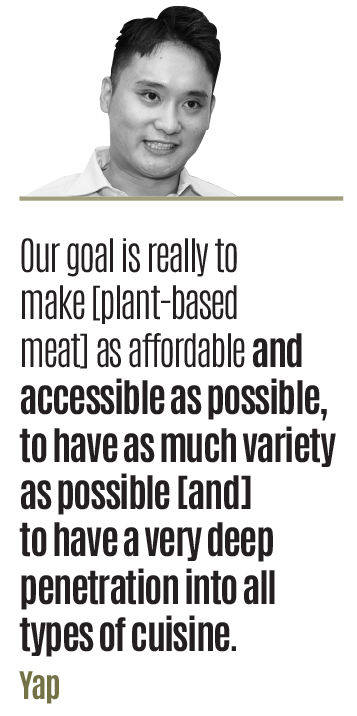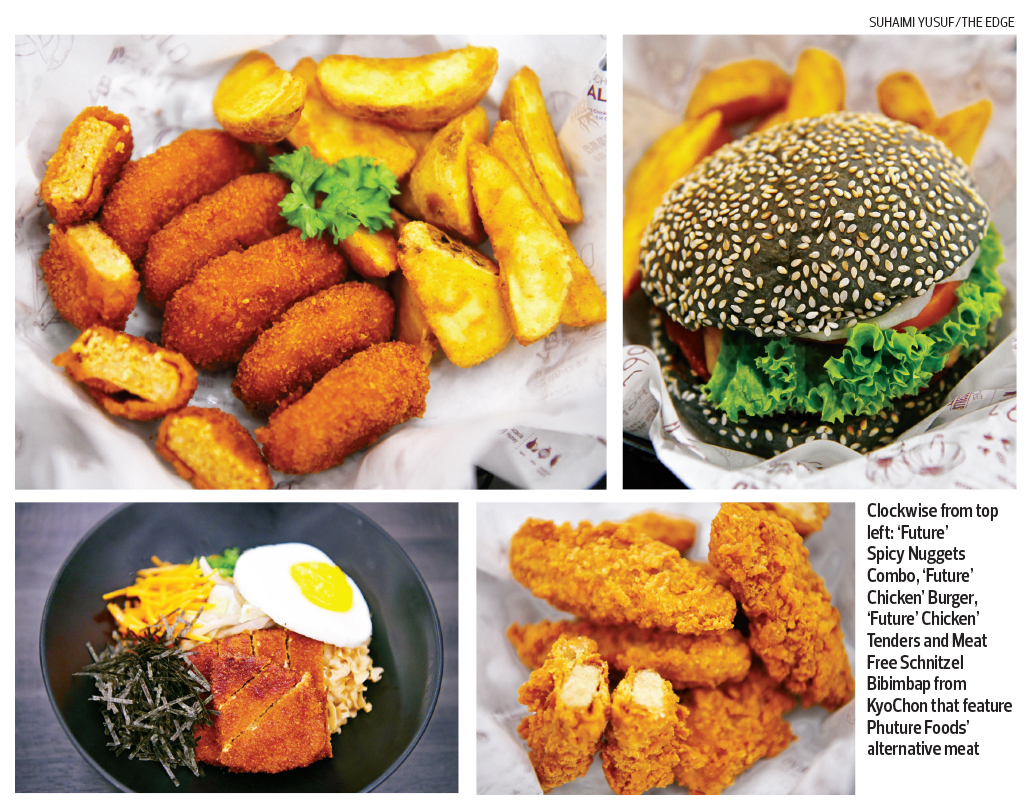
This article first appeared in The Edge Malaysia Weekly on September 22, 2022 - September 28, 2022
Demand for plant-based meat alternatives is growing steadily in Malaysia, a country where meat is still king. This is reflected in the growing number of these products sold in major grocery stores today.
Meat substitutes of the past did not taste or look like meat and tended to have an artificial aftertaste. With technological advancements, however, plant-based meat can now look and taste similar to actual meat.
“There are different kinds of technologies, [but] the most common one that is being adopted right now is protein extractions from different plants. [The plant-based meat] imitates the protein structure [of meat] and [it] is pasteurised into the [desired] texture,” says Jack Yap, founder of Phuture Foods Sdn Bhd.
The Malaysian company manufactures plant-based meat, with products like the High Fibre Chick’n Series, Invincible Mince (minced meat) and Burger Patees (burger patties).
Phuture’s products are available in KyoChon, one of the largest Korean fried chicken restaurant chains in Malaysia, as part of its meat-free menu. Phuture also supplies plant-based chicken popcorn at CU Mart, while supermarkets such as Jaya Grocer, Village Grocer and Aeon carry its products.
Yap founded the company in 2018. Prior to that, he was operating a couple of non-vegetarian restaurants. Ironically, he became a vegetarian at age seven after realising that chickens — which he thought of as his playmates — were slaughtered to become his meals.
“The restaurants were not serving plant-based meals because I just wanted to understand what it was that people ate … Then, a good friend of mine persuaded me to stop selling meat [and] look into plant-based meat,” he says.
This resonated with his childhood memories. So, Yap conducted further research into plant-based meat and partnered with three food scientists to create a recipe.
“I made a decision to venture into a vegetarian restaurant and tried to close all my meat restaurants. But it was really tough to run a vegetarian business. It’s hard to attract general meat eaters,” says Yap.
Addressing the hesitation of meat lovers
Plant-based meat is often seen as an ultra-processed food that is unhealthy. But Yap asserts that Phuture uses zero preservatives during the production stage. The company’s plant-based meat is made of a variety of plant protein, carbohydrates, natural colours and flavouring, according to its website.
Phuture uses technology to extract fibre from plants and imitate the structure and mouthfeel of meat, on a molecular level, in its plant-based products.
Its plant-based meat has the equivalent amount of fibre that can be found in regular protein products such as chicken, says Anabelle Co-Martinent, chief marketing officer of Phuture.
“Instead of eating all of that (fruits or vegetables), if you were to eat this (Phuture’s meat) with your rice or with other dishes, it would already give you the fibre intake [your body needs],” she says. Having a portion of Phuture’s plant-based meat per serving is equivalent to the consumption of 13g of fibre.
The World Health Organization (WHO) suggests that an average adult should consume at least 400g of fruits and vegetables each day, to ensure an adequate daily intake of dietary fibre.
Plant-based meat often has an overpowering taste of soybeans — its base ingredient — which can be a turn-off for some. Yap overcomes this by incorporating natural umami flavouring.
Vegetarian food options are not rare in Malaysia because many Buddhists and Hindus practise vegetarianism. Phuture is hoping to make vegetarianism even more accessible to the general public and integrate vegetarian food into local delicacies.
“To cater for various taste buds and businesses that want to experiment with plant-based meat recipes or include it in local meals like nasi lemak, Phuture can provide solutions and tailor the shape, size and texture of the plant-based products,” says Co-Martinent.
It is still a challenge, however, to convince meat eaters to try it.
“I am constantly trying to find solutions to entice meat eaters. We have tried different ingredients like quinoa, avocado and Himalayan pink salt and used different gimmicks to attract different meat eaters. Unfortunately, it hasn’t been successful and is still difficult [to do],” says Yap.
Can plant-based meat save the environment?
Both meat and plant-based products contribute to greenhouse gas (GHG) emissions. However, some studies have shown that plant-based meat substitutes are more likely to have a smaller carbon footprint than actual meat.
A comparative study was done by the University of Michigan on Beyond Meat’s original Beyond Burger (plant-based meat) and a quarter-pound beef burger patty in 2018. It found that Beyond Meat generated 90% less GHG emissions, required 46% less energy, and had less impact on water scarcity and 93% less impact on land use.
Nonetheless, it does not negate the fact that soybeans used in the production of plant-based meat have caused a strain on the planet. The World Wildlife Fund (WWF) reports that soybean cultivation has led to deforestation and displacement of small farmers and indigenous people around the globe.
“[We source] our soybeans from a global supply chain and they come from different places. We are still working on the traceability [to ensure the soybeans are sourced responsibly],” says Yap. Soybean and rice grain are Phuture’s main protein sources.
The key is to responsibly source and trace the legumes, ensure a transparent land-use planning process and promote responsible purchasing and investment policies, according to WWF.
Yap’s goal with Phuture is to reach a wider consumer base and introduce more varieties of plant-based meat. “Our immediate goal is to reach 400 million people. [For now, our customer base in] Malaysia is around 30 million [which is less than] 10% of what we want.
“We are not targeting a niche or healthy market. We want it to be [for the] mass market. We want to change the lives of everyone that we can possibly reach. So, our goal is really to make it as affordable and accessible as possible, to have as much variety as possible [and] to have a very deep penetration into all types of cuisine,” he says.
Save by subscribing to us for your print and/or digital copy.
P/S: The Edge is also available on Apple's App Store and Android's Google Play.
- Road closures, diversions during upcoming Chinese President Xi Jinping’s visit to Malaysia
- Fahmi gives telcos until 5pm today to resolve internet issues, or face stern action
- China's Xi vows to Indonesia's Prabowo to deepen partnership, Xinhua says
- Luxury confectioner looks to take LVMH-backed Saudi brand Bateel global
- London’s most desirable neighbourhoods have lost 11,000 workers
- Miti to present new analysis on impact of US tariffs at National Geo-Economic Action Council meeting on Monday
- Trump spares smartphones, computers, other electronics from China tariffs
- A new standard of urban elegance in North Kiara
- Start-up: Making freshwater prawns affordable
- Listicle: Escape to cosy town



